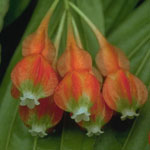James L. Luteyn and Paola Pedraza-Peñalosa
The New York Botanical Garden
|
|
Anthopterus (Ericaceae: Vaccinioideae: Vaccinieae) is a genus of 12 species ranging from Costa Rica to NE Peru. Most species are epiphytic shrubs found in premontane habitats. The genus is characterized by sympetalous flowers; inferior ovaries; calyces continuous with the pedicels and conspicuously 5-winged (in one case only strongly angled); corollas large, fleshy, conspicuously to narrowly 5-winged (in one case only sharply angled); tubules longer than the thecae and dehiscing by short to elongate clefts; and berry fruits. There is also the tendency towards opposite or verticillate leaves, and more or less geniculate stamens. There are few collections of any of the species and hence the range of variation within the genus is poorly known. Anthopterus is closely related to Thibaudia and Themistoclesia, but is traditionally separated from them by the conspicuously winged calyx and corolla of the former genus. For a detailed historical account of the genus see Luteyn (1996c). |
ANTHOPTERUS Hooker, Icon. Pl. 3: pl. 243. 1840. Type: Anthopterus racemosus Hooker.
Low shrubs or small trees, sometimes epiphytes. Leaves alternate, subopposite, or verticillate, coriaceous, margin entire, pinnate or plinerved. Inflorescence axillary, racemose, with several to many flowers; floral bract to 20 mm long but usually small and inconspicuous. Flowers 5-merous, without odor; aestivation valvate; calyx continuous with pedicel; hypanthium broadening distally and conspicuously 5-winged (in one case only strongly angled); limb suberect; lobes ovate to deltate; corolla subcylindric, cylindric-urceolate or subglobose, conspicuously to narrowly 5-winged (in one case only sharply angled), the lobes triangular, subacute to long-acuminate; stamen 10, essentially equal, nearly as long as the corolla, sometimes geniculate; filaments equal, distinct or basally slightly connate, shorter than anthers, lacking spurs; anthers dorsifixed, membranous, lacking istintegration tissue; thecae smooth; tubules longer than the thecae, dehiscing by short to elongate clefts; pollen lacking viscin threads; ovary inferior; stigma truncate; style filiform, about as long as the corolla; nectariferous disc annular or cupuliform. Fruit a berry (usually blue-black). Chromosome number unknown.
Key to Neotropical Species Back to Top
1. Leaves subopposite to verticillate (rarely alternate in A.
wardii), the base of
the lamina beneath lacking a circular gland
on each side of midrib; corolla
wings usually broadest towards apex (except A. verticillatus); corolla lobes
not so strongly reflexed as to expose stamens;
corolla reddish-orange at
base with a green band distally and white
limb and lobes; stamens geniculate;
western slopes of the Andes (subgen. Gonandra Luteyn).
2. Leaves alternate, up to 4(-11) cm
broad ............................... A.
wardii.
2. Leaves subopposite, opposite, or
verticillate, 3.5-10 cm broad.
3. Floral
bract 2-5 mm long at anthesis, much shorter than the
8-23 mm long pedicel.
4. Leaves 14-32 cm long, pinnately-nerved; inflorescence
subfasciculate, the 2-5 flowers arising from exfoliate or
older branches; calyx lobes wide-spreading at anthesis;
Cordillera Occidental of Cauca, Colombia, at 1875-2400 m
altitude ..................................................................
A. oliganthus.
4. Leaves up to 15 cm long, usually plinerved, rarely pinnate;
inflorescence a long-pedunculate raceme, the 4-13 flowers
scattered or distally clustered; calyx lobes erect,
± appressed to the corolla at anthesis; Pacific coast
from El Valle, Colombia to Cotopaxi, Ecuador, at 500-900 m
altitude ........................................................................ A. wardii.
3. Floral
bract 12-20 mm long, equal to or longer than the 3-15 mm
long pedicel.
5. Floral bracts broadly imbricate, appressed, 10-13 mm broad,
concealing the rachis, pedicel, and most of each flower at
anthesis ................................................................ A. verticillatus.
5. Floral bracts separated, spreading, 4-6 mm broad, not
concealing the rachis, pedicel, or flowers at anthesis.
6. Stem, rachis, pedicel, calyx, and sometimes corolla
puberulent; corolla obviously winged, broadest well
above the middle; calyx wings obvious, narrow and sharp;
Pacific lowlands of Colombia and Ecuador, at 400-1500 m
........................................................................... A. cuneatus.
6. Stem, rachis, pedicel, calyx and corolla glabrous,
although calyx rarely puberulent; corolla narrowly and
obscurely winged, broadest at or below the middle; calyx
wings relatively inconspicuous, blunt; Pichincha Prov.,
Ecuador, at 2200-2300 m ............................. A.
ecuadorensis.
1. Leaves strictly alternate, the base of the lamina beneath
with a circular
gland on each side of midrib; corolla
wings broadest at base; corolla
lobes so strongly reflexed that they expose
stamens; corolla color
whitish- or yellowish-green; stamens
not geniculate; Central America
and mostly eastern foothills of the Andes
of South America (subgen.
Anthopterus Hooker).
7. Leaves linear, strongly revolute
over entire length, less than 15 mm
broad, the venation
pinnate; corolla 7-9 mm long ................ A.
revolutus.
7. Leaves ovate, elliptic, to oblong-elliptic,
flat to only weakly
revolute, greater
than 10 mm broad, the venation plinerved (sometimes
weakly);
corolla (6-)7-20 mm long.
8. Leaf
base cordate and amplexicaul.
9. Leaves 9-13 cm long, the apex obtuse or bluntly acute;
inflorescence a stout raceme, with 12-21 flowers; rachis
4.5-11 cm long .................................................... A. costaricensis.
9. Leaves (4-)6-9 cm long, the apex obtusely cuspidate;
inflorescence a thin, 1-2--branched panicle, with each branch
2-5--flowered; rachis up to 4.5 cm long .....................
A. pterotus.
8. Leaf
base narrowly obtuse to rounded, at most only subcordate and
never amplexicaul.
10. Inflorescence 5-12--flowered; rachis 5-11 cm long;
pedicel
6-12 mm long; corolla 7-9 mm long, the lobes 2-3 mm long ...
.............................................................................. A. schultzeae.
10. Inflorescence 10-22--flowered; rachis 4.5-21 cm long;
pedicel 14-40 mm long; corolla (11-)13-20 mm long, the lobes
(3-)5-9 mm long.
11. Leaves broadly elliptic, 4-10 cm broad, the apex rounded,
or obtuse to bluntly acute; pedicel (16-)30-40 mm long;
corolla 18-20 mm long; staminal filaments glabrous .....
.......................................................................... A. gentryi.
11. Leaves ovate, 1.5-4 cm broad, the apex acuminate;
pedicel 14-22 mm long; corolla (11-)13-15 mm long;
staminal filaments glabrous or pilose.
12. Corolla ca. 15 mm long, the lobes ca. 9 mm long;
stamens 17.5-18 mm long, the filaments distinct,
pilose .......................................................... A. molaui.
12. Corolla ca. 11 mm long, the lobes ca. 3 mm long;
stamens 10-11 mm long, the filaments connate,
glabrous ................................................ A. racemosus.
This is an electronic version of Luteyn 1987b and 1996c, plus unpublished notes.
